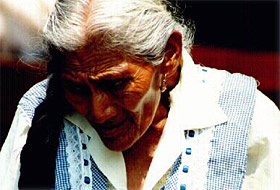 |
 |
 |
 Editorials | September 2005 Editorials | September 2005  
Retiring Mexican Immigrants Raise Questions
 Eduardo Porter & Elisabeth Malkin - NYTimes Eduardo Porter & Elisabeth Malkin - NYTimes


| | In the U.S., many would lack access to social services, and their homeland is not prepared to take them back. |
In recent decades, millions of working-age Mexicans have entered the United States. Most of them have come illegally, taking jobs on the bottom rungs of the American labor market.

While much of the attention remains on the persistent inflow of illegal workers, a new question is beginning to worry some analysts and policy-makers on both sides of the border: What will happen when the 10 million Mexicans living in the United States become too old to work? Will they retire in the United States or will they return to Mexico?

As they age, the choices these old-timers make could fray the social fabric on both sides of the border.

Mexico is not prepared to receive them back. With a rapidly aging population living in Mexico and virtually no public system of social security or health insurance, Mexico could hardly cope with millions of returning immigrants who spent their working lives in the United States.

"If we add to the dynamic of aging the return of Mexicans who don't have coverage," said Rodolfo Tuiran, a respected demographer who is undersecretary of social development in the Mexican government, "then we are talking about a significant problem."

But the United States is also unprepared to deal with millions of poor, aging immigrants eking out a living without recourse to Social Security, Medicare, Medicaid or most other forms of federal assistance.

In 2003, an estimated 710,000 Mexicans over 60 lived in the United States, 63 percent more than a decade earlier, the National Population Council of Mexico concluded, based on Census Bureau figures. About a quarter lived under the poverty line, a far greater share than the 10 percent of the overall elderly population who are poor.

Those numbers are expected to swell for the current generation of illegal immigrants. Unlike earlier migrants - many of them now legal residents in the United States - today's illegal immigrants are likely to see Social Security, Medicare or Medicaid as little more than mirages. While most have paid taxes over their working lives to these programs, under current law they are not entitled to any benefits.

"If all these people that came here are going to stay, then there is a question of what will be the social cost," said Roberto Suro, director of the Pew Hispanic Center in Washington. "If they're only here for their working life, it's a bargain."

Immigration policy, however, might be unwittingly contributing to an increase in the number of older Mexicans staying in the United States, as increasingly tight border controls encourage illegal immigrants to settle here rather than risk keeping families in Mexico and shuttling back and forth across the border.

Consider Angelita Sanchez de Valdez, who stepped into a rickety boat to cross the Rio Grande more than half a century ago, entering the United States illegally to join her husband and start a new life as a migrant farmworker. Today, Sanchez, an 83-year-old widow, is a U.S. citizen, and Mexico, she said, "is a little bit forgotten."

Living with her daughter and son-in-law in Donna, Texas, a parched town 10 miles from the border, Sanchez receives $453 a month from Social Security plus $81 in Supplemental Security Income, intended to improve the incomes of the poor. With no private insurance and no savings, she relies heavily on her daughter's good will, and on Medicaid to pay for prescription drugs and medical bills not covered by Medicare.

Given the nature of the movements across the border, there are no definitive statistics on return flows of older migrants to Mexico. But as the number of older immigrants starts adding up, 35 years after the flow of illegal workers across the border started to swell, the trickle of returning old-timers is gathering momentum.

An official survey of Mexican residents in 1990 found only 11,500 over 50 who had been living in the United States in 1985. By 2000, the number of Mexicans older than 50 who had been in the United States five years earlier rose to 27,900, according to the National Population Council.

One draw pulling Mexicans back home is affordability. "In little Mexico the money seems like a lot," said Roselino Sebastian Castaneda, 72, who returned nine years ago to his hometown in Tierra Caliente, Guerrero, after 35 years shuttling from California to Texas to Louisiana to Colorado to Montana.

He knows he could never afford to live in the United States on the $350 a month he collects from Social Security, the half of his benefit not swallowed by child support for a daughter in Arizona. But in Mexico, he said, "if I stop drinking and stop partying I can live on that."

Another draw is property. Almost half of Mexican immigrants over 50 own property in Mexico, according to a survey by the Pew Hispanic Center. The decision can come down simply to the nebulous yet powerful tug of nostalgia. | 
 | |
 |



